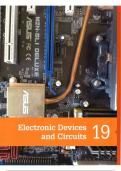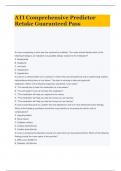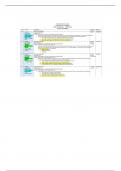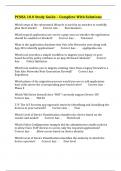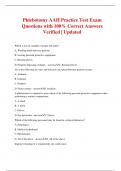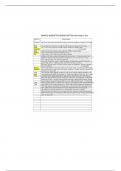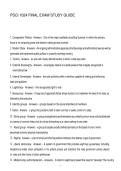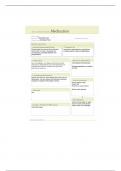AJfeff'"-'vi.,t diodes and transistors and combinational and sequential logic digital
This u11-it will be. circuits. As part of the unit you will use software to simulate circuits,
i;rsse.sse.d by or se.rie.s of construct them safely and use typical bench instruments to test them.
Electronic circuit designers make frequent use of software to simulate
orssi&11-me.11-ts se.t by your
design ideas before building prototype circuits and testing them in the
tutor. process of developing final products.
How you will be assessed
This unit will be assessed by a series of internally assessed tasks set by your tutor.
Throughout this unit you will find assessment activities to help you work towards your
assessment. Completing these activities will mean that you have carried out useful
research or preparation that will be relevant when it comes to your final assignment.
In order for you to achieve the tasks in your assignment, it is important to check that
you have met all of the assessment criteria. You can do this as you work your way
through the assignment.
The assignments set by your tutor will consist of a number of tasks designed to meet
the criteria in the table.
Assessment criteria
This table shows what you must do in order to achieve a Pass, Merit or Distinction grade, and where
you can find activities to help you.
Pass Merit Distinction
Leaming aim m Explore the safe operation and applications of analogue devices
and circuits that form the building blocks of commercial circuits.
ijijl
Simulate, using captured schematics, the
•a~••
Simulate, using accu rately captured
••••
Evaluate, using language that is technically
correct operation of at least one diode, schematics, the correct operation of at correct and of a high standard, the
transistor and operational amplifier circuit. least one diode, transistor and operational operation of at least one diode, transistor
Assessment practice 19.1 amplifier circuit. and operational amplifier circuit,
Assessment practice 19.1 comparing the results from safely and
•:>•
Build at least one diode, transistor and
operational amplifier circuit safely and test
i!tMfl
Build at least one diode, transistor and
operational amplifier circuit safely and test
accurately conducted simulations and
tests.
Assessment practice 19.1
the characteristics of each one. the characteristics of each one accurately.
Assessment practice 19.1 Assessment practice 19.1
lj@I
Explain , using the simulation and test Analyse, using the simulation and test
results, the operation of at least one diode, results, the operation of at least one diode,
transistor and operational amplifier circuit. transistor and operational amplifier circuit.
Assessment practice 19.1 Assessment practice 19.1
384 Electronic Devices and Circuits
, Getting to know your unit
!:!!
Pass Merit Distinction ro
()
...,
.......
0
Leaming aim : Explore the safe operation and applications of digital logic devices =i
;:::;·
and circuits that form the building blocks of commercial circuits.
0
ro
i :l«Ji l :l&G• l :l•>W :S.
()
ro
Simulate, using captured schematics, Simulate, using accurately captured Evaluate the operation of at least one Vl
JlJ
the correct operation of at least one schematics, the correct operation of at combinational logic circuit minimising =i
0..
combinational logic circuit and two least one combinational logic circuit the gates and two sequential bidirectional
logic circuits, comparing the results
0.
...,
sequential logic circuits. minimising the gates and at least two ()
sequential bidirectional logic circuits. from safely and accurately conducted c
Assessment practice 19.2 ;:;:
Vl
Assessment practice 19.2 simulations and tests.
Assessment practice 19.2
Build at least one combinational logic Build at least one combinational logic
circuit and two sequential logic circuits circuit minimising the gates and at least
safely and test the characteristics of each two sequential bidirectional logic circuits
one. and test the characteristics of each one
Assessment practice 19.2 accurately.
Assessment practice 19.2
l :IM
Explain, using the simulation and test Analyse, using the simulation and test
results, the operation of at least three logic results, the operation of at least three logic
circuits. circuits.
Assessment practice 19.2 Assessment practice 19.2
.,.
Leaming aim Review the development of analogue and digital electronic
circuits and reflect on your own performance .
Explain how health and safety and
electronic and general engineering
Recommend improvements to the
development of the electronic circuits and
• ••
Demonstrate consistently good
technical understanding and analysis
skills were effectively applied during the to the relevant behaviours applied. of the electronic circuits, including the
development of the circuits. Assessment practice 19.3 application of relevant behaviours and
Assessment practice 19.3 general engineering skills to a professional
standard.
Assessment practice 19.3
MiQ:I
Explain how relevant behaviours
were applied effectively during the
development of the circuits.
Assessment practice 19.3
385
, Getting started
Do you understand the difference between analogue and digital circuits?
What electronic applications have you already studied? Have you constructed
any electronic circuits? What methods have you used? Look through the unit
content and make a list of what you think you already know something about.
As part of the unit you need to compare your initial skills and knowledge with
your final ones and see how they have developed. Be honest!
Explore the safe operation and applications of
analogue devices and circuits that form the building
blocks of commercial circuits
At Safe electronic working Emergencies
You must know what to do, and what not to do, in case of
practices fire, electrocution or other emergency.
Electronics safety
Working with electronic circuits can be dangerous if you Research )
do not take sensible precautions. Here are some safety
For your workplace and work practices:
guidelines to keep you safe as you work.
Find out who is responsible for health and safety.
~ Only work with low-voltage supplies and never work on
Find out who the identified first-aiders are and how
a circuit while power is applied.
to contact them.
~ Check your work carefully before connecting power to Find the appropriate risk assessments.
a circuit. Familiarise yourself with the evacuation procedures.
~ Keep your work area clean, dry and tidy. Find out where you can find safety equipment such
as fire extinguishers and first-aid kits.
~ Be very careful when you solder because a hot soldering
iron can easily burn you.
'
~ Always work in a well-ventilated space, as soldering can
Schematic capture and simulation
give off potentially harmful fumes.
One of the important skills that you need to develop is
~ Wear safety glasses when constructing circuits.
the ability to understand and create schematic circuit
~ Always follow the guidelines in appropriate risk diagrams. There are many software packages that allow
assessments. you to do this - see Figure 19.1 for an example. They
~ Be able to identify people with responsibility for health range from free downloads from the internet to expensive
and safety and always follow their instructions. professional packages used in industry. They all have
As well as protecting yourself and others, you should certain things in common. A key factor is the number of
also take care to avoid damage to components. Some components stored in their libraries and how easy it is to
components are sensitive to static electricity, and you use them. You want to be able to find the components you
should take precautions to avoid damage by electrostatic need quickly so that you can drag and drop them into your
discharge (ESD). A good start is to keep your work area drawing window. Each component you include in your
clean and tidy so that there are no materials, such as design is given a unique identifier, for example Rl. You
plastic bags, that might build up a static charge. Handle then need to be able to connect your components. This is
circuit boards by their edges where possible. Keep sensitive usually done just by dragging from point to point.
components in their packaging until you need to use them. The libraries also contain a variety of signal sources,
You might carry out construction in a designated area sensors and actuators. You need to practise using the
with static dissipation work surfaces and floor and proper software applications so that you can work with them
grounding methods, such as a wrist strap. confidently and efficiently.
386 Electronic Devices and Circuits


